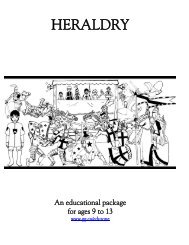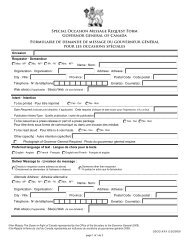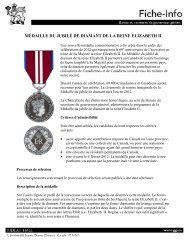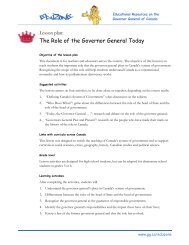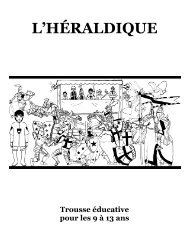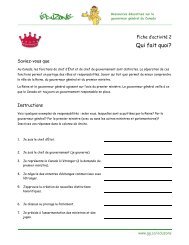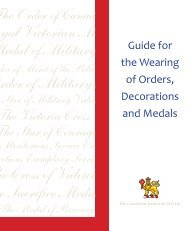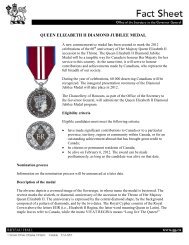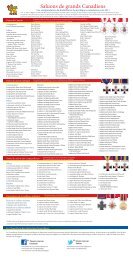Heraldry—An Educational Package for Ages 9 to 13
Heraldry—An Educational Package for Ages 9 to 13
Heraldry—An Educational Package for Ages 9 to 13
You also want an ePaper? Increase the reach of your titles
YUMPU automatically turns print PDFs into web optimized ePapers that Google loves.
Where does heraldry come from?<br />
From ancient times <strong>to</strong> the 11th century, the use of symbols as indications of<br />
identity was widespread. These symbols were often the same because ancient<br />
conflicts were usually between groups whose differences in clothing and equipment<br />
made it easy <strong>to</strong> distinguish between them. There was little chance that combatants<br />
on the same side of a battle would not be able <strong>to</strong> recognize each other. Unlike<br />
heraldry, these ancient emblems were not governed by particular rules. The<br />
ownership of an emblem was not exclusive, nor permanent, nor hereditary.<br />
Heraldry did not develop until the 12th century, and it was the evolution of<br />
military equipment that led <strong>to</strong> the development of coats of arms. Prior <strong>to</strong> this time, a<br />
soldier’s helmet included a nasal guard, a small piece of metal covering the nose.<br />
For more complete protection, the soldier also wore a hood of chain mail (made of<br />
interlocking rings of iron) that covered the lower part of the face and neck. It was<br />
the development of the full helmet (or pot helm) that led <strong>to</strong> the adoption of coats of<br />
arms. This happened gradually: first, the back of the helmet was lengthened <strong>to</strong><br />
cover the nape of the neck, and the nasal guard was expanded <strong>to</strong> cover the cheeks as<br />
well. Then, the helmet became cylindrical by the attachment of metal plates that<br />
covered the ears and the <strong>for</strong>ehead. Eventually, the helmet did not have any openings<br />
except <strong>for</strong> the eyes and several ventilations holes.<br />
Nasal helm<br />
Pot helm<br />
This new type of military outfit protected the knight during battle and made<br />
him <strong>to</strong>tally unrecognizable. The face of the soldier was hidden in much the same<br />
way as the face of a hockey goalie is hidden <strong>to</strong>day. Then, as now, the helmet was<br />
designed <strong>to</strong> protect against blows. Only the material used in the manufacturing of<br />
the mask has changed.<br />
Consequently, the soldier, now resembling a tin can, began <strong>to</strong> decorate his<br />
shield with simple figures, colours, shapes, animals or floral symbols, so that<br />
soldiers on his side could recognize him in the confusion of battle.<br />
8 | 41 www.gg.ca/eduzone



